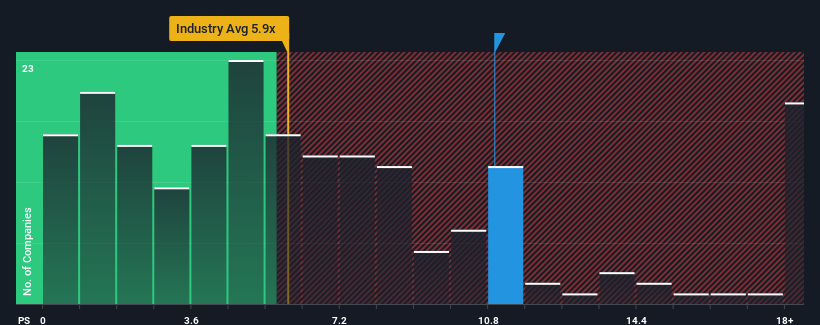- China
- /
- Semiconductors
- /
- SHSE:688173
With A 27% Price Drop For Halo Microelectronics Co., Ltd. (SHSE:688173) You'll Still Get What You Pay For
The Halo Microelectronics Co., Ltd. (SHSE:688173) share price has fared very poorly over the last month, falling by a substantial 27%. The recent drop completes a disastrous twelve months for shareholders, who are sitting on a 56% loss during that time.
Although its price has dipped substantially, Halo Microelectronics may still be sending strong sell signals at present with a price-to-sales (or "P/S") ratio of 10.9x, when you consider almost half of the companies in the Semiconductor industry in China have P/S ratios under 5.9x and even P/S lower than 2x aren't out of the ordinary. However, the P/S might be quite high for a reason and it requires further investigation to determine if it's justified.
View our latest analysis for Halo Microelectronics

How Halo Microelectronics Has Been Performing
Halo Microelectronics could be doing better as its revenue has been going backwards lately while most other companies have been seeing positive revenue growth. It might be that many expect the dour revenue performance to recover substantially, which has kept the P/S from collapsing. However, if this isn't the case, investors might get caught out paying too much for the stock.
Keen to find out how analysts think Halo Microelectronics' future stacks up against the industry? In that case, our free report is a great place to start.Do Revenue Forecasts Match The High P/S Ratio?
Halo Microelectronics' P/S ratio would be typical for a company that's expected to deliver very strong growth, and importantly, perform much better than the industry.
Retrospectively, the last year delivered a frustrating 29% decrease to the company's top line. However, a few very strong years before that means that it was still able to grow revenue by an impressive 74% in total over the last three years. So we can start by confirming that the company has generally done a very good job of growing revenue over that time, even though it had some hiccups along the way.
Turning to the outlook, the next year should generate growth of 137% as estimated by the lone analyst watching the company. Meanwhile, the rest of the industry is forecast to only expand by 34%, which is noticeably less attractive.
With this in mind, it's not hard to understand why Halo Microelectronics' P/S is high relative to its industry peers. It seems most investors are expecting this strong future growth and are willing to pay more for the stock.
The Final Word
Halo Microelectronics' shares may have suffered, but its P/S remains high. Generally, our preference is to limit the use of the price-to-sales ratio to establishing what the market thinks about the overall health of a company.
We've established that Halo Microelectronics maintains its high P/S on the strength of its forecasted revenue growth being higher than the the rest of the Semiconductor industry, as expected. It appears that shareholders are confident in the company's future revenues, which is propping up the P/S. It's hard to see the share price falling strongly in the near future under these circumstances.
Before you settle on your opinion, we've discovered 1 warning sign for Halo Microelectronics that you should be aware of.
If companies with solid past earnings growth is up your alley, you may wish to see this free collection of other companies with strong earnings growth and low P/E ratios.
Valuation is complex, but we're here to simplify it.
Discover if Halo Microelectronics might be undervalued or overvalued with our detailed analysis, featuring fair value estimates, potential risks, dividends, insider trades, and its financial condition.
Access Free AnalysisHave feedback on this article? Concerned about the content? Get in touch with us directly. Alternatively, email editorial-team (at) simplywallst.com.
This article by Simply Wall St is general in nature. We provide commentary based on historical data and analyst forecasts only using an unbiased methodology and our articles are not intended to be financial advice. It does not constitute a recommendation to buy or sell any stock, and does not take account of your objectives, or your financial situation. We aim to bring you long-term focused analysis driven by fundamental data. Note that our analysis may not factor in the latest price-sensitive company announcements or qualitative material. Simply Wall St has no position in any stocks mentioned.
About SHSE:688173
Halo Microelectronics
Engages in the design, development, and sale of analog and power management integrated circuit products worldwide.
Flawless balance sheet with high growth potential.
Market Insights
Community Narratives



